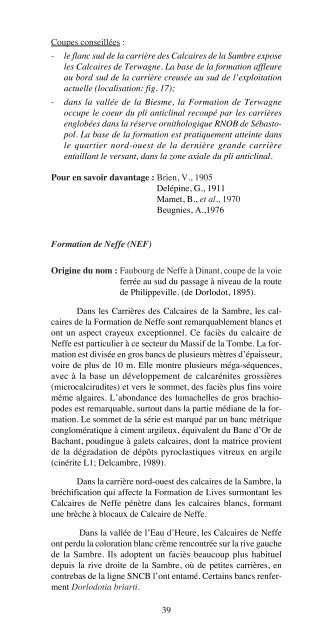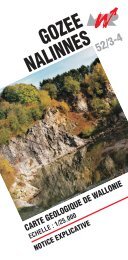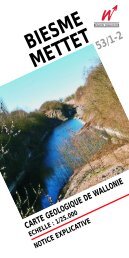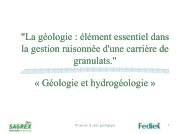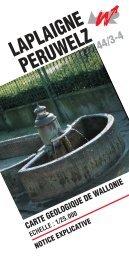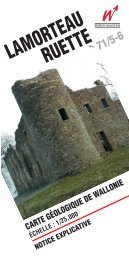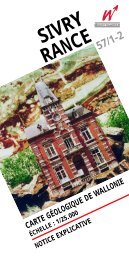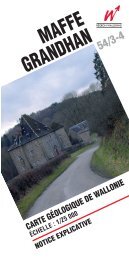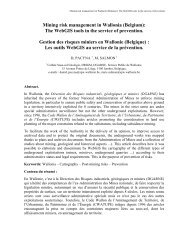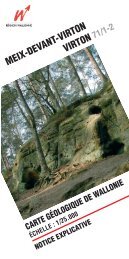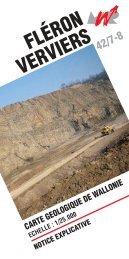Télécharger le fichier - Service géologique de Wallonie
Télécharger le fichier - Service géologique de Wallonie
Télécharger le fichier - Service géologique de Wallonie
You also want an ePaper? Increase the reach of your titles
YUMPU automatically turns print PDFs into web optimized ePapers that Google loves.
Coupes conseillées :- <strong>le</strong> flanc sud <strong>de</strong> la carrière <strong>de</strong>s Calcaires <strong>de</strong> la Sambre expose<strong>le</strong>s Calcaires <strong>de</strong> Terwagne. La base <strong>de</strong> la formation aff<strong>le</strong>ureau bord sud <strong>de</strong> la carrière creusée au sud <strong>de</strong> l’exploitationactuel<strong>le</strong> (localisation: fig. 17);- dans la vallée <strong>de</strong> la Biesme, la Formation <strong>de</strong> Terwagneoccupe <strong>le</strong> coeur du pli anticlinal recoupé par <strong>le</strong>s carrièresenglobées dans la réserve ornithologique RNOB <strong>de</strong> Sébastopol.La base <strong>de</strong> la formation est pratiquement atteinte dans<strong>le</strong> quartier nord-ouest <strong>de</strong> la <strong>de</strong>rnière gran<strong>de</strong> carrièreentaillant <strong>le</strong> versant, dans la zone axia<strong>le</strong> du pli anticlinal.Pour en savoir davantage : Brien, V., 1905Delépine, G., 1911Mamet, B., et al., 1970Beugnies, A.,1976Formation <strong>de</strong> Neffe (NEF)Origine du nom : Faubourg <strong>de</strong> Neffe à Dinant, coupe <strong>de</strong> la voieferrée au sud du passage à niveau <strong>de</strong> la route<strong>de</strong> Philippevil<strong>le</strong>. (<strong>de</strong> Dorlodot, 1895).Dans <strong>le</strong>s Carrières <strong>de</strong>s Calcaires <strong>de</strong> la Sambre, <strong>le</strong>s calcaires<strong>de</strong> la Formation <strong>de</strong> Neffe sont remarquab<strong>le</strong>ment blancs etont un aspect crayeux exceptionnel. Ce faciès du calcaire <strong>de</strong>Neffe est particulier à ce secteur du Massif <strong>de</strong> la Tombe. La formationest divisée en gros bancs <strong>de</strong> plusieurs mètres d’épaisseur,voire <strong>de</strong> plus <strong>de</strong> 10 m. El<strong>le</strong> montre plusieurs méga-séquences,avec à la base un développement <strong>de</strong> calcarénites grossières(microcalcirudites) et vers <strong>le</strong> sommet, <strong>de</strong>s faciès plus fins voiremême algaires. L’abondance <strong>de</strong>s lumachel<strong>le</strong>s <strong>de</strong> gros brachiopo<strong>de</strong>sest remarquab<strong>le</strong>, surtout dans la partie médiane <strong>de</strong> la formation.Le sommet <strong>de</strong> la série est marqué par un banc métriqueconglomératique à ciment argi<strong>le</strong>ux, équiva<strong>le</strong>nt du Banc d’Or <strong>de</strong>Bachant, poudingue à ga<strong>le</strong>ts calcaires, dont la matrice provient<strong>de</strong> la dégradation <strong>de</strong> dépôts pyroclastiques vitreux en argi<strong>le</strong>(cinérite L1; Delcambre, 1989).Dans la carrière nord-ouest <strong>de</strong>s calcaires <strong>de</strong> la Sambre, labréchification qui affecte la Formation <strong>de</strong> Lives surmontant <strong>le</strong>sCalcaires <strong>de</strong> Neffe pénètre dans <strong>le</strong>s calcaires blancs, formantune brèche à blocaux <strong>de</strong> Calcaire <strong>de</strong> Neffe.Dans la vallée <strong>de</strong> l’Eau d’Heure, <strong>le</strong>s Calcaires <strong>de</strong> Neffeont perdu la coloration blanc crème rencontrée sur la rive gauche<strong>de</strong> la Sambre. Ils adoptent un faciès beaucoup plus habituel<strong>de</strong>puis la rive droite <strong>de</strong> la Sambre, où <strong>de</strong> petites carrières, encontrebas <strong>de</strong> la ligne SNCB l’ont entamé. Certains bancs renfermentDorlodotia briarti.39


